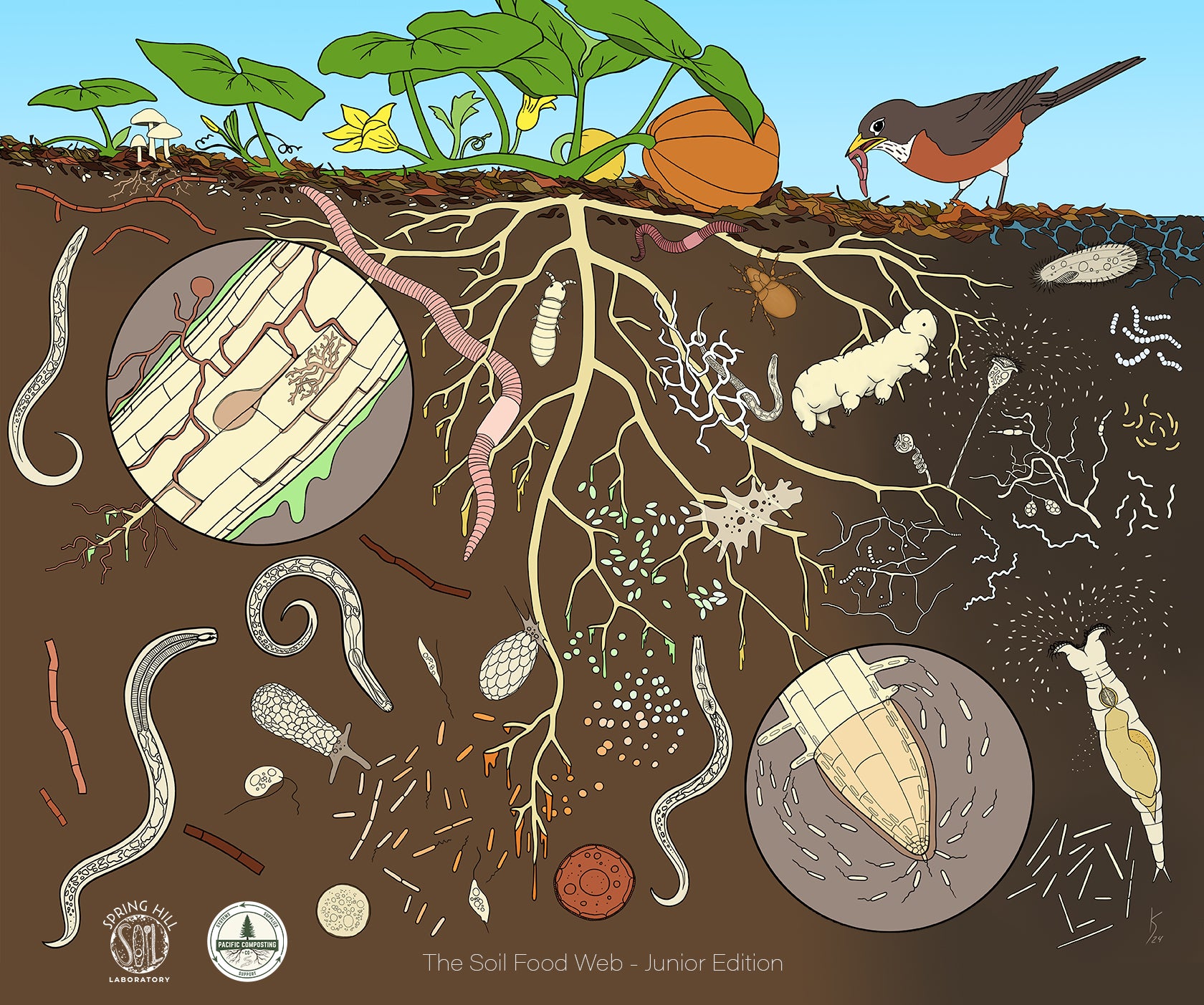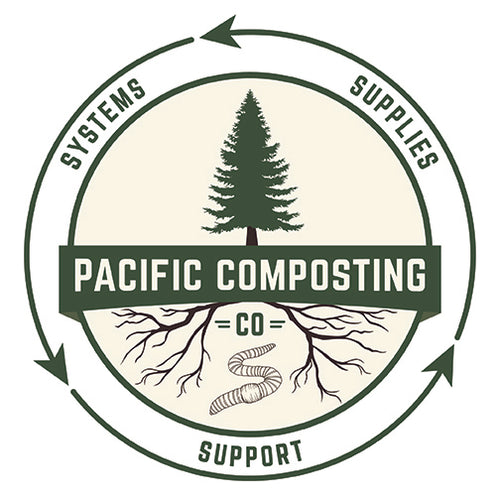
KidZone

Pacific Composting Co and Spring Hill Soil Laboratory have collaborated to develop these soil food web educational tools and resources!
We are super excited for kids (and adults) to learn more about the soil superheroes living right beneath our feet! These awesome beings work tirelessly, breaking down organic matter and the the parent materials in soil (rocks, sand, silt, clay) and recycling nutrients to keep our ecosystems healthy.
With a range of sheets featuring different micro animals and other key players in the soil food web, kids can learn while they create. Imagine a colourful world where bacteria and fungi are the heroes, turning waste into food for plants.
Parents and teachers, download and enjoy our free colouring sheets and inspire a love of the soil food web!
Air-Loving Protozoa
Did you know, there is air in the soil? Plants want to hang out with microbes that like these airy conditions, too. Protozoa are key players in the soil food web, munching down about 10,000 bacteria a day and pooping them out so that plant roots can take up the nutrients (food) that they need. Protozoa are poop-loop stars!
Wet Soil-Loving Protozoa
Wet soil-loving protozoa show up when there is less air in the soil, as in when the soil is flooded with water. Like air-loving protozoa (who either die or go to sleep when the air levels drop), wet soil-loving protozoa enjoy munching on bacteria. They also poop lots of nutrients back out into the soil...but watch out! Beautiful as they are to see under the microscope, we don't want to see too many zooming around. Healthy soil needs more air than these guys like. Often we will see these types of protozoa in worm bins, because the worms live in conditions that are usually a bit wetter than healthy soil. A worm has to be able to slither, after all!
Plant-Beneficial Nematodes
Nematodes sometimes get a bad rap. While there are plenty of parasitic nematodes that like to attack plants, there are also lots of plant-beneficial ones, too! Nematodes are fun to watch under the microscope.
We are happy when we can find bacterial-feeding nematodes, because we know that they are eating bacteria and pooping it out, which is great for plants. When we see fungal feeding nematodes, that is exciting because it means there must also be lots of their food source around (fungi, of course!). Bacterial feeding omnivores are fun because they have really cool big mouths. They will chow down on bacteria, plus anything that will fit in that mouth!
And last but not least, get ready for the predatory nematodes. These big guys feast on - you guessed it - other nematodes. Top of their menu seems to be the nematodes that like to attack plants. Then after that, all of the smaller nematodes are fair game! Can you see the big tooth in the predatory nematode's mouth?
Bacterial-Feeding Nematodes
Bacterial-feeding nematodes usually have a mouth that looks a bit like a cylinder or a small tube, and often a little pump further down. They use this pump to suck in fluid that contains their favourite food. Can you guess what they eat? You got it, bacteria! And lots of it. We often see a LOT of these nematodes in young compost piles, and you can find them in a healthy worm bin, too.
Fungal-Feeding Nematodes
There are different types of fungi that help plants. Some join up with plant roots and trade goodies with the plant, helping the root to extend further into the soil to gather water and nutrients (food).
Other types of fungi spend their time decomposing things in the soil. They take up nutrients in their bodies, and the plant could sure use some of these nutrients, but it can't reach them. Enter fungal-feeding nematodes! Now, fungi are very good at building a protective wall around themselves. So fungal feeding nematodes need a "spear" to be able to pierce the edges of the fungi, to get in. Once in, they suck out the contents of the fungi, eventually pooping this out in a form that the plant can then enjoy.
Sometimes you will see a really tiny spear (called a stylet), and sometimes a much wider spear. Nematodes move fast so we often have to be patient to see if it is really a spear, or the cylindrical mouth of a bacterial-feeding nematode, but it is worth the effort! We love fungal-feeding nematodes!
If you have fungal-feeding nematodes in your worm-bin, give yourself a pat on the back. It means that you have a good fungal population in there, and that's what we really want to see for healthy plants!
Root-Feeding Nematodes
Root-feeding nematodes are a type of parasitic nematode. If the plant root isn't covered and protected by other micro-organisms, root-feeding nematodes can find their way to an exposed, juicy section of root. They use their spear to pierce the root, and then suck out the contents for a tasty meal. As you can imagine, plants aren't into this very much. Which is why we want to see all of the other soil food web organisms hanging out in the root zone, feeding the plant and protecting it from pesky root-feeding nematodes.
There is a type of fungus that specialises in catching nematodes for dinner, and while it will munch on any nematode it can trap with it's rings, it has a particular taste for root-feeding nematodes. Yum.
You can tell a root-feeding nematode from a fungal-feeding nematode by whether you can see large knobs at the base of the spear. It takes more effort to pierce a root than it does to get into the wall of a fungal hypha, requiring knobs that can be pulled back and released.
Rotifer
Rotifers are a type of micro-animal with a mesmerising way of feeding. First they anchor their tail to something solid, and then the spinning starts! They catch their favourite food with two spinning rotors on the top of their head. They spin and spin, catching bacteria, chowing down on the yummy ones and spitting out the ones that don't taste so good.
We could watch them for hours! Usually we find them in wetter places... like a worm bin!
Tardigrade
Tardigrades, otherwise known as water bears, are hardy wee things. They can survive a trip into space (although not happily), and if things get too much, they can go dormant and stay dormant for hundreds of years until conditions get better. Tardigrades are survivors! And boy, do they look cute when they are busily clawing away, looking for food. Tardigrades have 4 sets of legs, which they use to hook onto things as they slowly lumber around, and a cylindrical mouth for sucking up food.
We usually find these micro-animals in wet environments, like tucked away in some moss (hence their other name, "moss piglets"). Sometimes we see them in soil or compost that has been a bit on the wetter side. And when we do, we sit and watch. For quite a while!
Microarthropods
Microarthropods are like very, very tiny insects that you might be able to catch with your naked eye but that you will need a microscope or some other type of magnification to be able to see clearly. We often see springtails (Collembola) and mites (Acari) at healthy soil surfaces and in composts where there is a lot of leafy material. They also live in the deeper layers of the soil (you will definitely need a microscope to see those ones, which tend to be smaller).
Microarthropods are invertebrates (no bones), instead they have a segmented outer shell (or exoskeleton). They are the "grazers" of the soil food web, eating bacteria and fungi. We also see them as "shredders", breaking down dead leaves and such into smaller parts that then feed the rest of the soil food web.
We get excited to see them! If you find them in your worm bin, this usually means there is fungi in your system. Well done you!
Worm
As we move on up through the soil food web, we go from the smallest of organisms up to predators of higher and higher levels. It really is all about who is eating who! And at the end of the day, it's the poop that plants are interested in, no matter what the size of the organism or animal that is letting it out.
Worms are higher level predators in the soil. Did you know that their favourite food is actually soil microbes? So all that food that you are adding to your worm bin... the worms are eating up the microbes that come in on it. And then after the food particles go through the worm's body, it comes out in a size that can be eaten by smaller microbes, and on it goes. Nothing is wasted in nature.
Learn about our colouring contest!
Bird
Worms have predators too! Birds like to eat compost worms that are hanging out in the layer of decaying plant matter on the soil surface, and they also like to chow down on earth worms that live deeper in the soil. Especially when it's raining and those worms come up to the surface.
Have you ever seen a robin hopping around on your lawn, with it's head cocked to one side? It is listening for worms!
Can you think of a predator that would like to eat the bird?











